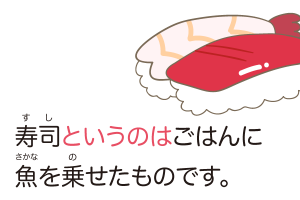Last time, you learned topic-related expressions, e.g. “アイヌ語というのは北海道の一部で話されている言葉のことだ (Ainu languages is a language spoken in part of Hokkaido),” and “北海道といえば、私は何度か行ったことがある (As for Hokkaido, I have been there some times).” Then, if you would like to say, “Ainu languages is a language spoken in only part of Hokkaido,” how should you say it? In this lesson, you will learn how to express limitation.
Explanation for How to Express Limitation in Japanese
| Table of Contents The Wide Usage of 限る Other Expressions for Limitation |
You already know the word だけ to indicate limitation. だけ is certainly a powerful word and is used in various situations. In fact, the sentence: “Ainu languages is a language spoken in only part of Hokkaido“ can be expressed by だけ like this “アイヌ語というのは北海道の一部でだけ話されている言葉のことだ.” However, there are some types of limitation that だけ cannot express.
The Wide Usage of 限る
限る literally means “to limit” and “to restrict.” You can utilize this verb for various expressions. The one that we introduced in the partial negation lesson is one of the utilization, e.g. “アイヌ語が話されているのは北海道だけとは限らない (It’s not necessarily that Ainu language is spoken in only Hokkaido).” The conjugation is the key.
The Plain Form 限る: To Indicate “Restricted” and “Only”
| 申請書の提出は日本語に(限る / 限ります)。 Submission of the application is restricted to Japanese. |
| 新製品の発売は15日に(限る / 限ります)。 The sale of the new product is [held] only on the 15th. |
The basic function is to express restriction of something. The target of restrictions is expressed by に. This sounds a little formal. Then, here is a different function. 限る can also express the best thing in a certain topic like “As for X, Y is better than anything.” By contrast, this is mainly used in conversation and sound casual.
| 夏はビールに(限る / 限ります)。 In summer, beer is better than anything. |
| 音楽はライブに(限る / 限ります)。 As for music, live is better than anything. |
The Te-form …に限って
に限って has two functions. The first is to express that something inconvenient happens particularly when you had hoped nothing would happen. This is generally used with time expressions in both writing and conversation. In this case, it may not be strictly limited to occurring in only that time/situation.
| 日曜日に限って、いつも雨が(降る / 降ります)。 It always rains, particularly on Sundays. |
| 旅行中に限って、仕事の電話がたくさん(ある / あります)。 There are many business calls, particularly during travels. |
The second is to express something like “You wouldn’t expect X to do/be Y” or “X would be the last person to do Y.” In general, に限って works as a subject marker and is used with the negative form. Be careful. This may sound like a strong statement.
| 田中さんに限って決まりは(破らない / 破りません)。 As for rules, Tanaka-san would be the last person to break [it]. |
| スポーツ選手に限って体力がないことは(ない / ありません)。 Athletes would be the last people you’d expect to not have physical strength. |
Some people utilize the second function for emphasizing and pointing out bad activities. This may grammatically be not correct, but used to express irony.
| 政治家に限って悪いことを(する / します)。 It’s the politicians who do bad things (rather than X). |
The Conjunctive Form …に限り: Certain Rules Apply to a Restricted Group
| 18歳以上の人に限り入場することができます。 Only people who are over 18 years old can enter. |
| 学生に限り、料金は無料です。 As for the price, it’s only free for students. |
に限り is a formal way of expressing that authorized people apply certain rules to a restricted group of people. The sentence structure is a little tricky. If you are confused by the structure, you can reword them as follows:
| 18歳以上の人は入場することができます。 |
| 学生は料金は無料です。 |
In this context, you can replace に限り with に限って or だけ and make your speech less formal.
| 18歳以上の人 に限って・だけ 入場することができます。 |
| 学生に限って・だけ、料金は無料です。 |
Don’t be confused with the noun form of 限る. The 限り in the following example works as a noun and that’s different from the function of the conjunctive form.
| iPhoneは在庫に限りがあります。 As for iPhones, there is a limit on the stocks. |
| 予算に限りがあるので、全てを買うことはできません。 Since there is a limit on our budget, [we] cannot buy everything. |
[adsense]
Negative Conjunctive Form …に限らず: To Negate/Soften Limitation
| 年寄りに限らず若者も癌になることが(ある / あります)。 There is a case where not only the elderly but also the young get cancer. |
| タバコは場所に限らず禁止にして欲しい(です)。 As for cigarettes, [I] want [the government] to ban [them] regardless of the place. |
に限らず works to negate or soften limitation. With the first example, the new range is mentioned, i.e. from the elderly to the young. However, making ranges unlimited is also common, as in the second example.
Supplementary Subordinate Clauses …を限りに: Time Limit
| 3月末を限りに引退(する / します)。 [I] will retire by the end of March. |
| 今日を限りに退職(する / します)。 [I] will resign by the end of today. |
を限りに is used with time expressions and indicate time limit. You can grammatically consider the を限りに part as a subordinate clause. In this context, を限りに is often interchangeable for で and をもって.
| 3月末で引退(する / します)。 |
| 今日をもって退職(する / します)。 |
Other Expressions for Limitation
There are still other expressions which are not interchangeable with だけ and 限る. They express “ranges” rather than “limitation.” For the sake of completion, we would like to cover all of them here.
…にかけては: Prominence in a Certain Field
| 語学力にかけては、誰にも負け(ない / ません)。 When it comes to language skills, [I] am second to none. |
| 発音にかけては、私が一番上手い(です)。 When it comes to pronunciation, I’m the best. |
The function is to indicate prominence in a field specified by にかけては. In terms of the sentence structure, you may consider the にかけては part as a kind of topic marker.
…ならでは(の): Specialty
| 生の魚を食べるのは日本ならでは(だ / です)。 Eating raw fish is a specialty of Japan. |
| カレーを手で食べるのはインドならでは(だ / です)。 Eating curry by hand is unique to India. |
ならでは is used with だ/です and indicates specialty or uniqueness like “something you can experience only in that place” or “something that only X can do.” This can be also used with の to modify nouns as follows:
| それはナポレオンならではの戦い方(だった / でした)。 That’s a style of fighting that only Napoleon could do. |
| 日本ならではの料理が食べたい(です)。 [I] want to eat special meals that [I] can only get in Japan. |
…(は / なら)ともかく: Exclusion
| 田中はともかく、他の人に許可は出せ(ない / ません)。 [I] cannot give permission to anyone apart from Tanaka. |
| 漢字はともかく、ひらがなは書けた方がいい(です)よ。 [You] should be able to write hiragana apart from kanji. |
| 熱があるならともかく、風邪で仕事は休め(ない / ません)。 [I] cannot be absent from work due to cold unless [I] have fever. |
| 仕事ができないならともかく、どうして井上さんをクビにした(の / んですか)? Why did [you] fire Inoue-san if it’s not the case that [he/she] is incapable? |
(は / なら)ともかく expresses the exclusion of something from consideration. は and なら are interchangeable. However, なら is the one used in conditionals, so なら can be connected to any part of speech and implies a hypothetical condition. That is to say, with the third example, he/she doesn’t have fever in reality. With the fourth example, Inoue-san is not incapable in reality.
Summary
- Each form of 限る expresses limitation with different nuances;
- 限る expresses restriction of something.
- に限って expresses that something inconvenient happens particularly when you had hoped nothing would happen.
- に限って also expresses “You wouldn’t expect X to do/be Y” or “X would be the last person to do Y.”
- に限り expresses that authorized people apply certain rules to a restricted group of people.
- に限らず works to negate or soften limitation.
- を限りに is used with time expressions and indicates a time limit.
- …にかけては expresses prominence in a certain field.
- ならでは(の) indicates specialty or uniqueness.
- (は / なら)ともかく expresses the exclusion of something from consideration.
限る can mean various things depending on the form, but don’t worry, this is kind of an unusual verb. Japanese verbs generally don’t have multiple meanings like 限る. Now, you know how to express limitation in various ways. Next, you will learn the opposite concept: how to express addition.

Topic-related Expressions: というのは, といえば, and だが

How to Express Addition: だけでなく, ばかりか, もちろんのこと, and にとどまらず



